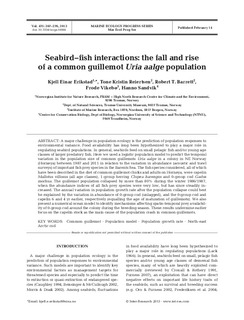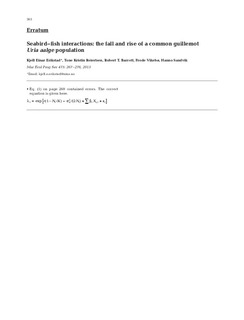| dc.contributor.author | Erikstad, Kjell E. | |
| dc.contributor.author | Reiertsen, Tone Kristin | |
| dc.contributor.author | Barrett, Robert T. | |
| dc.contributor.author | Vikebø, Frode | |
| dc.contributor.author | Sandvik, Hanno | |
| dc.date.accessioned | 2013-10-23T12:14:16Z | |
| dc.date.issued | 2013-02-14 | |
| dc.identifier.citation | Erikstad KE, Reiertsen TK, Barrett RT, Vikebø F, Sandvik H (2013) Seabird–fish interactions: the fall and rise of a common guillemot Uria aalge population. Mar Ecol Prog Ser 475:267-276 | no_NO |
| dc.identifier.issn | 0171-8630 | |
| dc.identifier.issn | 1616-1599 | |
| dc.identifier.uri | http://hdl.handle.net/11250/109206 | |
| dc.description.abstract | A major challenge in population ecology is the prediction of population responses to environmental variance. Food availability has long been hypothesized to play a major role in regulating seabird populations. In general, seabirds feed on small pelagic fish and/or young age classes of larger predatory fish. Here we used a logistic population model to predict the temporal variation in the population size of common guillemots Uria aalge in a colony in NE Norway (Hornøya) between 1987 and 2011 in relation to the variation in abundance (acoustic and trawl surveys) of important fish prey species in the Barents Sea. The fish species considered, all of which have been described in the diet of common guillemot chicks and adults on Hornøya, were capelin Mallotus villosus (all age classes), 1-group herring Clupea harengus and 0-group cod Gadus morhua. The guillemot population collapsed by more than 80% during the winter 1986/1987, when the abundance indices of all fish prey species were very low, but has since steadily increased. The annual variation in population growth rate after the population collapse could best be explained by the variation in abundance of 0-group cod (unlagged), and the 0-group cod and capelin 6 and 4 yr earlier, respectively (equalling the age of maturation of guillemots). We also present a numerical ocean model to identify mechanisms affecting spatio-temporal prey availability of 0-group cod around the colony during the breeding season. These results undermine earlier focus on the capelin stock as the main cause of the population crash in common guillemots. | no_NO |
| dc.language.iso | eng | no_NO |
| dc.publisher | Inter-Research | no_NO |
| dc.subject | arctic cod | no_NO |
| dc.subject | arktisk torsk | no_NO |
| dc.subject | stock assessment | no_NO |
| dc.subject | bestandsberegning | no_NO |
| dc.title | Seabird−fish interactions: the fall and rise of a common guillemot Uria aalge population | no_NO |
| dc.type | Journal article | no_NO |
| dc.type | Peer reviewed | no_NO |
| dc.subject.nsi | VDP::Agriculture and fishery disciplines: 900::Fisheries science: 920::Aquaculture: 922 | no_NO |
| dc.description.embargo | 2018-02-14 | |
| dc.source.pagenumber | 267-276 | no_NO |
| dc.source.volume | 475 | no_NO |
| dc.source.journal | Marine Ecology Progress Series | no_NO |
| dc.identifier.doi | 10.3354/meps10084 | |


